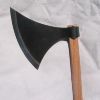JimStC
Member
LC, what kind of an edge can you put on that Estwing? Do you know its weight?
Whetrock, you focused on my primary reason for owning the VTAC: Self defense. I have one in my truck and fishing boat, although in all honesty it will probably be the second or third tool I would grab when needed. My disappointment is the difficulty of getting a good edge on the main cutting blade which I guess does relegate it to a defense tool. A friend who is retired LEO, when I showed it to him said " I would rather be shot than hit with that".
All that said, I am starting to recognize that there are other non-firearm tools which are as useful as my hawks. For a long time I have been a traditionalist in terms of self defense : concealed carry and a good knife. Upon reading some of the threads on THR, my thoughts concerning self defense are evolving toward a much broader concept of the term self defense and the tools for that purpose.
Thanks to everyone for your comments and advice
Jim
Whetrock, you focused on my primary reason for owning the VTAC: Self defense. I have one in my truck and fishing boat, although in all honesty it will probably be the second or third tool I would grab when needed. My disappointment is the difficulty of getting a good edge on the main cutting blade which I guess does relegate it to a defense tool. A friend who is retired LEO, when I showed it to him said " I would rather be shot than hit with that".
All that said, I am starting to recognize that there are other non-firearm tools which are as useful as my hawks. For a long time I have been a traditionalist in terms of self defense : concealed carry and a good knife. Upon reading some of the threads on THR, my thoughts concerning self defense are evolving toward a much broader concept of the term self defense and the tools for that purpose.
Thanks to everyone for your comments and advice
Jim


